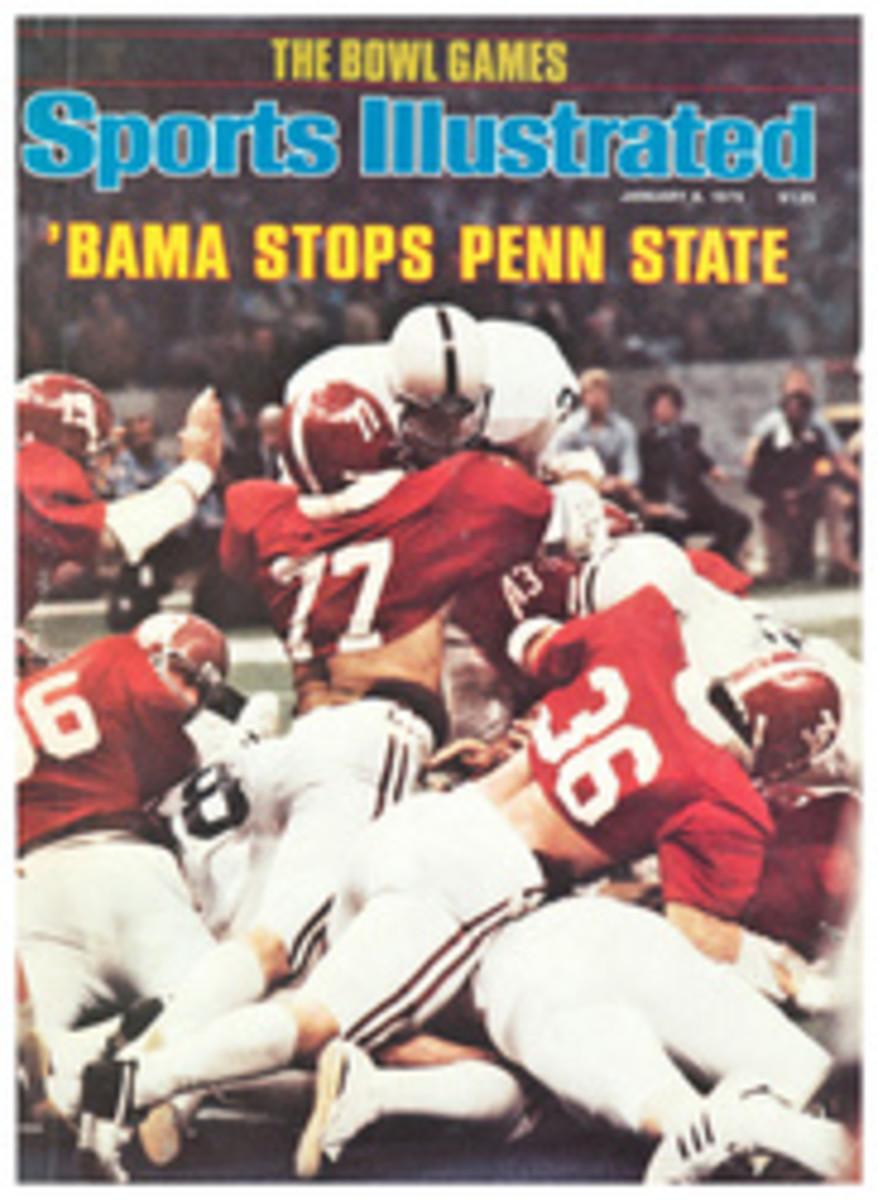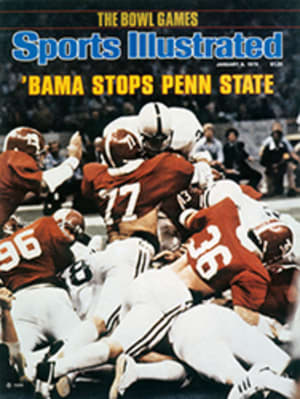
The Juniors sure ain't child's play
The Orange Bowl World Junior Tennis Championships is not only the quintessential international juniors tournament, but it also is the best amateur tournament you will ever see for free. Since 1966 these players have won either the boys' or the girls' 18-and-under division: Manuel Orantes, Peaches Bartkowicz, Mike Estep, Chris Evert, Dick Stockton, Harold Solomon, Corrado Barazzutti, Bjorn Borg, Billy Martin and, last year, Ivan Lendl. Ivan who? Just wait. People asked the same question when John McEnroe won two years ago.
But equally impressive is the caliber of people who have not won on the clay of Miami Beach's Flamingo Park: John Newcombe, Arthur Ashe, Jimmy Connors, Vitas Gerulaitis, Guillermo Vilas, Brian Gottfried, Eddie Dibbs, Stan Smith and Bob Lutz.
The tournament has two divisions for boys and girls, 16s and 18s, and last month involved 320 kids from 41 countries playing at two different sites in Miami. It always takes place the week before Christmas, when the earth moves into a new season. Indeed, in a way the Orange Bowl is the sun of the junior tennis world, promising bright days or dictating dark nights. No matter how good you are, it is a tournament far easier to lose than to win.
The frustrations of the waiting game on clay are immense, and added to these are a host of improbable, bizarre and at times downright comical aggravations, which give the Orange Bowl its special stamp. One year the fathers of Harold Solomon and Dick Stockton got into a fistfight. Belligerent fans question calls. Coaches yell in foreign languages. The indigent elderly of the South Beach forage among the competitors' tuna-fish sandwiches, trying to cadge a free meal. Jet planes scream overhead.
No wonder that 18-year-old Claudio Panatta, the younger brother of pro Adriano Panatta and the sweetheart of the sidelines, couldn't take it anymore. In the fourth round the handsome Italian found himself standing in a swirling wind against a wild opponent, Fritz Buehning, 18, of Short Hills, N.J., who already twice had stopped play, demanding, among other things: an umpire, banishment of spectators, a cessation of the control-tower chatter emanating from the loudspeaker system at the registration desk, ball boys, water and, most important, an end to the stream of players and fans walking behind the court, "causing," said Fritz, "me to go loony." In the face of all this, Claudio finally lost his concentration and the match. At one point he became so enraged he crushed his racket on the court, splintering it into a grotesque shape. It lay there like a bleached skeleton, a symbol of the frustration of the Orange Bowl.
Buehning explained his victory by saying, "His mind snapped. He's kind of a sick person. Considering that, I would have been crazy not to do what I did."
Trying to keep from going bonkers is the name of the game at the Orange Bowl tournament. The courts at Flamingo Park are lined up side by side in three rows, so that if you're not stepping on a ball from another court, you're stepping on another player. Umpires are at a premium, and those that do call selected matches seem to have been dragged off a Collins Avenue chaise longue. Their average age is about 70, and they wear sunglasses and sit hunched and shrunken in their chairs, calling out the scores in raspy croaks and frequently changing their minds when players or fans dispute their calls. At one point, during an interminable girls' match, a player complained she couldn't hear the umpire. "Get a hearing aid," he screeched back.
This is also one of few tournaments where there are no linesmen except in the finals, and a player will practice in a bathing suit, as one entrant did, or four doubles players will warm up without shirts, causing the tournament director, Donald Petrine, to wail.
The event was founded in 1946 by Eddie Herr, who is now 71. He haunts the registration desk, where he is identifiable by his sunglasses, straw hat and dark coat as much as by his bellicose manner. When speaking, Herr is fond of sticking a finger in your chest. He is one of the original Sunshine Boys. One day he was arguing with Gabriel Urpi, the Spaniard who was on his way to winning the boys' 18s. Urpi has a neutron forehand, a shot that leaves the net standing but kills opponents. Onlookers compared it with Borg's lethal top-spin forehand. Herr was arguing that Gabriel hit perilously hard. Gabriel just smiled. The old generally are afraid of chances. The young almost never can take enough.
Junior is a euphemism anyway, like calling a jungle killer a mercenary. You think of a junior as infantile, often frail, someone to be nursed and coddled. A junior in tennis is anyone 18 years or younger. They rip into shots, don't know fear, play tournaments all over the world and are trained to be as reliable as solid-state circuitry. Blaine Willenborg, of Miami Shores, who lost to Urpi in the quarterfinals, remembers when he and his father hit the ball back and forth over the net 672 times just before Blaine's ninth birthday. His father was the one who missed.
The juniors are so well organized that Pepsi-Cola gives the contestants computer points toward world Grand Prix standings. Equipment manufacturers hand out a cornucopia of goods; even 12-year-olds get free rackets. Tennis federations sponsor travel expenses, and tournament promoters ladle out airplane tickets and provide lodging. Says Tim Mayotte, the top-ranked American junior, "Sometimes you feel just like a piece of meat."
In some respects, juniors are at the top of their games. There are no wraps on their knees or elbows. Their reflexes and eyes never fail. All they need is the leavening of experience, another couple of turns on the forge.
Andrea Jaeger of Lincolnshire, Ill., who is 13, won the girls' 18s at the Orange Bowl, the youngest ever to do so. She is an 80-pound moppet who is as mentally tough as any pro. Man or woman. She lost one set during the tournament, and she lost it 6-0, on center court during the semifinals against Bettina Bunge, daughter of Swiss parents, who now lives in Coral Gables and who at 15 has every shot in tennis. Then Jaeger, this little 13-year-old in pigtails and braces, won the next two sets 6-1, 6-2, and in the final set the moppet turned guerrilla fighter. Bettina called a ball "out," and Jaeger started yelping, "Oh no! Oh no!" And she marched around the net and over to her opponent's side, while the crowd yelled and the umpire leaned perilously out of his chair, calling for quiet and reason. Andrea wasn't going to lose this point. Oh no. She wailed and screamed. Her father came out of the stands and waved his arms. When the umpire ruled that the point would be replayed, Andrea didn't like it one bit. "You wait," she yelled, marching back to the other side. "The next time one is close, I'm calling it out." But she won the next point, the game and the match.
Andrea Jaeger is obstinate and unyielding. Against opponents with more polished games, such as Bettina, she keeps lobbing the ball back until they make a mistake. Against lesser opposition such as Rosalyn Fairbank of South Africa, whom she destroyed in the final 6-1, 6-3, she is haughty and disdainful, running her opponent around with her whipping forehand and two-hand backhand.
Andrea already has won eight national titles and gone to the finals of a major 21-and-under event. She wields a $200 graphite racket and wears out a pair of tennis shoes every two weeks. The best boy in the 12s, Robbie Weiss, plays her frequently but never has won more than two games from her. "He's always asking some other girl to play, just so he can beat a girl," Andrea shrugs.
Needless to say, the other Orange Bowl competitors were not too thrilled about a 13-year-old beating them. Andrea couldn't find a doubles partner and one of those who turned her down was the No. 1 seed, Maria Rothschild, 18, of St. Louis. But the tennis world might as well become accustomed to her. She's going straight to the top.
The status of the Orange Bowl tournament can be judged by the fact that seemingly every college tennis coach in America was there. One even put up a notice advertising a full scholarship for whoever wanted it. The competition to get an invitation to the tournament is fierce. Last year Petrine received a letter from a Japanese coach that read, "Players dream Orange Bowl. Please make dream come true." Actually, players from 42, not 41, countries entered. One guileful youngster, Steve Mayer, 17, of New York City, who is ranked about 15th in Central Park, listed himself on his entry blank as the top-ranked player in Bulgaria. It worked. His entry was accepted, and Steve wound up paired in the first round against the No. 1 seed, Cassio Motta of Brazil. Mayer breezily told Petrine, "Thanks for putting me against Motta. He looks fat." And to Victor Garvin, his 77-year-old former mentor from Central Park, Steve said, "I'll take the sucker out." Then he strutted onto center court, wearing sunglasses and a Tacchini warmup suit, a colorful handkerchief tied debonairly around his neck. He was carrying four rackets. Cassio had only two.
During the warmup, Steve completely whiffed an overhead and volleyed one shot cleanly over the back fence as Cassio stared at him with a look at once quizzical and suspicious. But when they began playing it quickly became apparent that Bulgaria's top entry was not a wolf in designer's clothing. Steve won a total of about five points, losing the match 6-0, 6-0 as the few spectators who had not wandered off, including about 15 players standing in a corner, hooted and jeered him unmercifully.
Still, he refused to lose his dignity. "I had so many games 30-30, but just couldn't win the big points," he said. "Those Europeans are tough on clay."
Someone pointed out Motta was Brazilian. "It's all the same," Steve shrugged.
Gabriel Urpi, meanwhile, romped through the 128-player field as Borg did in 1972, running around his backhand on every important point. Seeded only fifth, he lost a mere two sets and each time roared back stronger. "Every time he is down, that is when he plays better tennis," said Edison Mandarino, who was in charge of the group of Spanish players. In the final, Gabriel won 10 straight games in one stretch from a disconsolate Schalk van der Merwe, a South African, and triumphed 6-3, 6-1. His Spanish followers then carried him around the court, chanting his name. When they set him down, Gabriel was ready to go on to the next challenge.
PHOTO
Gabriel Urpi displayed his lethal forehand.
PHOTO
Andrea Jaeger, 13, was youngest to win the 18s.

